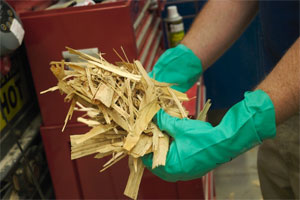Understand and Separate Wood Components
 Research Goal: Change wood into chemicals and extractives.
Research Goal: Change wood into chemicals and extractives.
Woody biomass from our forests will be used to create new bio-products: transportation fuels, wood-based chemicals, consumer products and electrical energy to reduce our reliance on fossil fuels. Innovative uses for sustainably harvested wood have great potential to reinvigorate forest management strategies, help landowners conserve forest lands, and transform industrial facilities into bio-refineries that manufacture many valuable wood products at one location.
Questions Researchers Ask
How do we change the wood so that we can simultaneously make building and paper products as well as bioproducts? How ill using different portions of a tree affect the amount, quality, and cost to produce bioproducts? Can advanced scientific tools explore the molecular structure of woody materials, allowing us to develop new processes and bioproducts? Can cellulose nanofibers be used to improve coatings and plastics.
 “UMaine wants to augment the pulp and paper and building products industries with new revenue streams that include transportation fuels as well as high-profit margin chemicals to make coatings, plastics for tubs for butter or fenders for cars, and maybe even nanotechnology products. These bioproducts would leave a smaller, lighter ecological footprint.”
“UMaine wants to augment the pulp and paper and building products industries with new revenue streams that include transportation fuels as well as high-profit margin chemicals to make coatings, plastics for tubs for butter or fenders for cars, and maybe even nanotechnology products. These bioproducts would leave a smaller, lighter ecological footprint.”
— Dr. Hemant Pendse, FBRI
